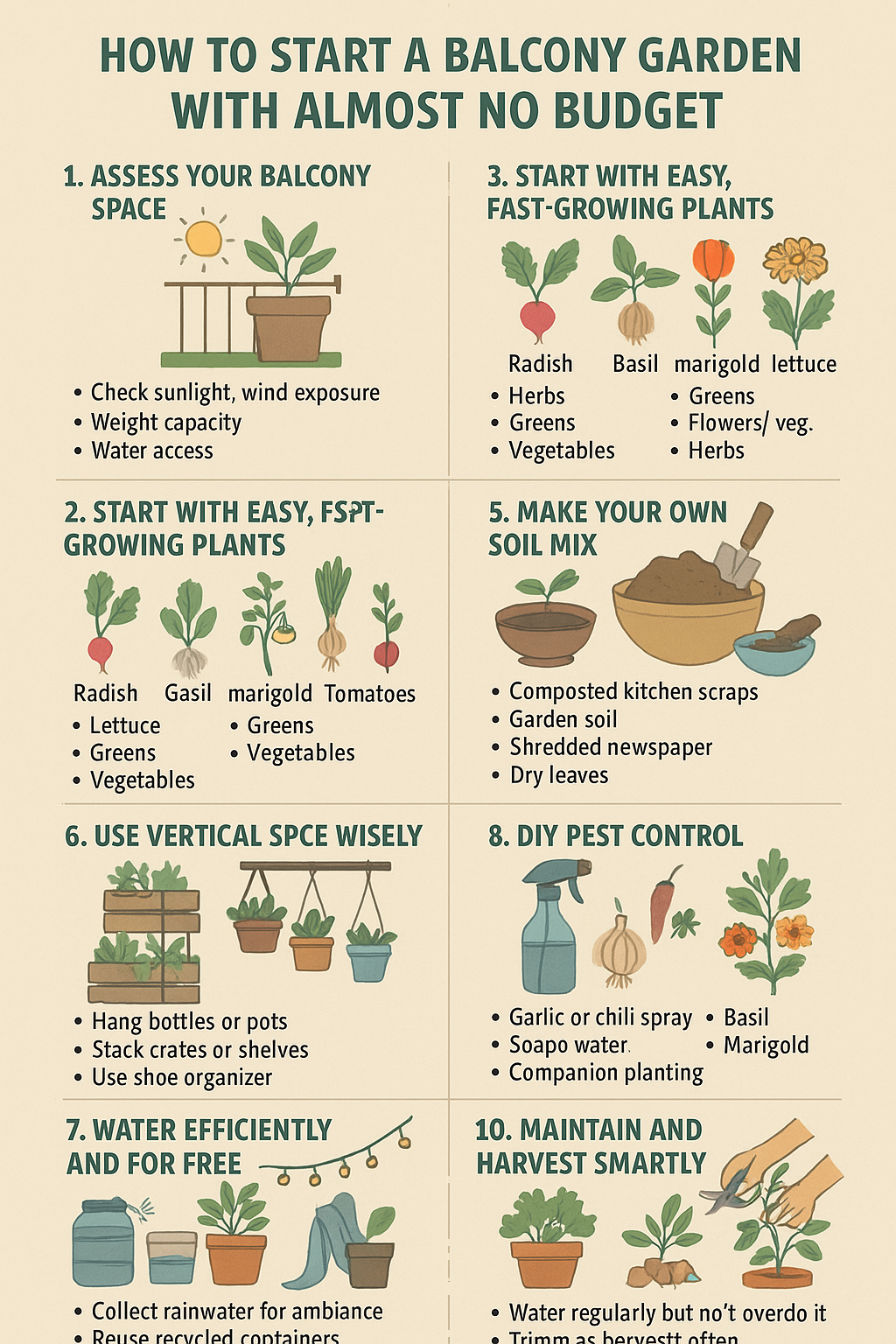Don’t let limited space or finances stop you from growing your own green oasis. With a little creativity, even the smallest balcony can be transformed into a thriving garden — and you don’t need to spend much (or anything) to get started. In fact, some of the most beautiful and productive balcony gardens are built using repurposed items, low-maintenance plants, and homemade solutions.
Here’s a complete guide to help you set up a charming and productive balcony garden while keeping costs near zero.
Step 1: Assess Your Balcony Space
Before bringing in any plants or containers, evaluate your balcony:
- Sunlight: Observe how many hours of direct sunlight your balcony gets daily.
- 6+ hours: Full sun
- 3–6 hours: Partial sun
- Less than 3 hours: Shade
- Wind exposure: Balconies can be windy. Choose sturdy containers and wind-tolerant plants.
- Weight capacity: If you’re using larger containers, be aware of how much weight your balcony can support.
- Water access: How easily can you water your plants? This will help you decide on plant types and irrigation systems.
Step 2: Use Recycled Containers as Planters
You don’t need fancy pots. Use what you already have or what you can find for free:
- Plastic bottles: Cut them in half to use as small pots.
- Old buckets and basins: Great for larger plants.
- Tin cans and jars: Perfect for herbs and succulents.
- Styrofoam boxes: Lightweight and good for deeper-rooted veggies.
- Wooden crates: Can be turned into raised beds with minimal tools.
Make sure to add drainage holes and, if possible, line the bottom with gravel or pebbles.
Step 3: Start with Easy, Fast-Growing Plants
Choose plants that are low-maintenance and offer quick results — especially when you’re on a budget. Great options include:
- Herbs: Basil, mint, parsley, oregano, green onions
- Greens: Lettuce, spinach, arugula
- Flowers: Marigolds, nasturtiums, petunias
- Vegetables: Cherry tomatoes, radishes, chili peppers
These can often be grown from seeds, scraps, or cuttings, which saves money and helps you learn faster.
Step 4: Use Kitchen Scraps to Grow New Plants
Instead of buying seedlings, regrow plants from your kitchen waste:
- Lettuce and celery: Place the root base in water and watch it sprout.
- Green onions and garlic: Regrow in water or soil from trimmed ends.
- Tomatoes and peppers: Use seeds from ripe vegetables.
- Herbs: Root basil and mint cuttings in water, then transplant.
These methods are fun, free, and beginner-friendly.
Step 5: Make Your Own Soil Mix
Buying soil can be costly, but you can create your own mix using:
- Composted kitchen scraps
- Garden soil (if available nearby)
- Shredded newspaper or cardboard
- Dry leaves and small twigs
- Used coffee grounds and eggshells
Mix well and monitor drainage — a good soil mix should retain moisture but drain excess water quickly.
Step 6: Use Vertical Space Wisely
If your balcony is small, go vertical:
- Hang bottles or pots on walls or railings.
- Stack crates or shelves to hold multiple plants.
- Use shoe organizers as a hanging herb garden.
- Build a trellis from sticks or string for climbing plants like beans or cucumbers.
Vertical gardening helps you grow more plants in less space, and it looks amazing too.
Step 7: Water Efficiently and for Free
Watering daily can increase your utility bill — so reuse water whenever possible:
- Collect rainwater using buckets or tubs.
- Reuse vegetable rinse water (unsalted and clean).
- Store cooking water (unsalted) to cool and water your plants later.
- Use old spray bottles for misting and gentle watering.
Just make sure reused water doesn’t contain soap, oil, or chemicals.
Step 8: DIY Pest Control
Avoid chemical sprays by making your own pest repellents:
- Garlic or chili spray: Blend garlic or chili with water and spray on leaves.
- Soapy water: A few drops of dish soap in water helps remove pests like aphids.
- Companion planting: Grow marigolds or basil to naturally repel insects.
Also, check plants regularly to catch any issues early.
Step 9: Decorate With Purpose
Make your space look good without spending a dime:
- Use string lights or old bulbs for ambiance.
- Paint recycled containers for a colorful look.
- Use fabric scraps or old shirts as plant holders or covers.
- Add pebbles, stones, or shells for natural decoration.
Creativity and personality can make even the most budget-friendly balcony garden feel luxurious.
Step 10: Maintain and Harvest Smartly
Once your garden is set up, follow a few basic rules to keep it growing strong:
- Water regularly but don’t overdo it — check the soil first.
- Trim and harvest often to encourage new growth.
- Rotate containers if plants are leaning toward the sun.
- Keep notes — track what works and what doesn’t.
Gardening is about learning through doing. The more you engage with your plants, the better your results — even with minimal resources.
Enjoy the Rewards of a Low-Cost Balcony Garden
Starting a balcony garden with almost no budget is entirely possible — and incredibly rewarding. With recycled materials, a little patience, and some repurposed scraps, you can grow herbs, flowers, and vegetables right outside your door.
Beyond the money saved, the peace of mind and pride you gain from growing your own green space are priceless.
